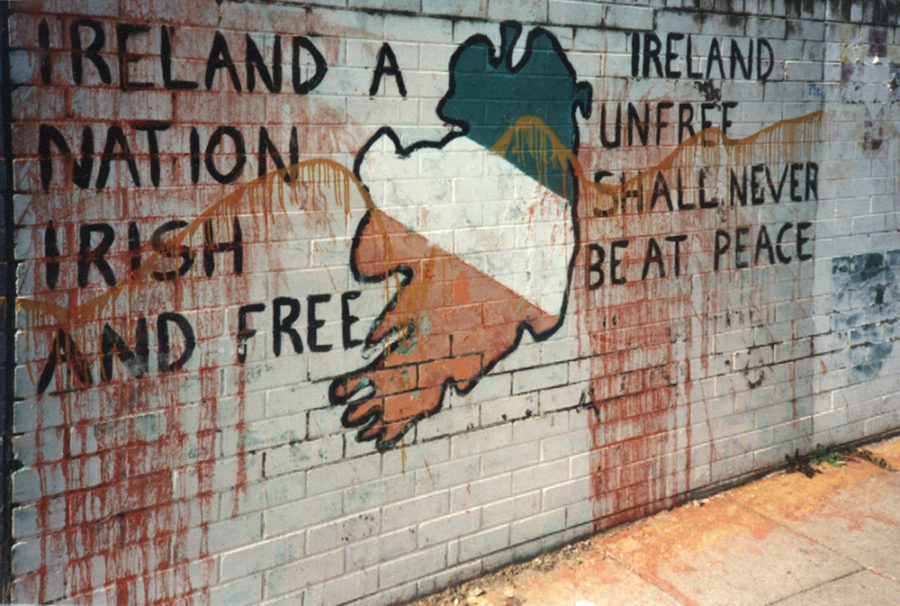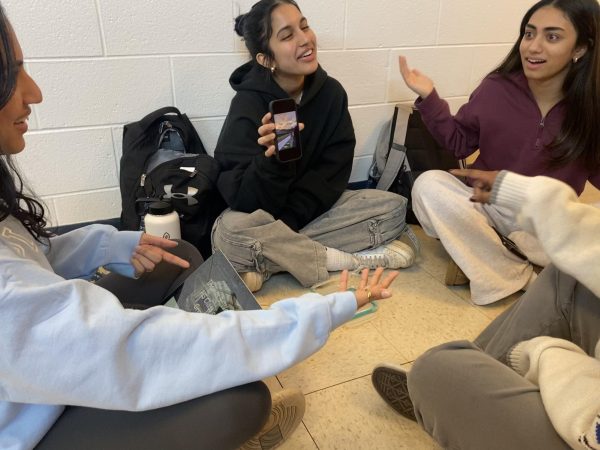The World Is Ending: Luck of the Irish
Photo used with permission from Wikimedia Commons
Nationalist graffiti on a public wall in the Northern Irish town of Derry. Everyday citizens were drawn into the conflict, which resulted in over 3,000 deaths, as towns became unofficial battlefields for bombings and snipers.
On St. Patrick’s Day we found our school teeming with mischievous little people clad in green, swarming the hallways and dancing around to popular Irish-themed music in the Commons at lunch. While they might seem like leprechauns at first glance, closer investigation revealed that they were indeed just freshmen.
As per tradition, Friday, Mar. 17 found students ransacking their closets for the singular green article of clothing they own, and decking themselves to the nines with shamrocks and lucky four-leaf clovers to celebrate St. Patrick’s Day.
But, just how lucky are the Irish exactly?
At first glance: not very. Their world has come dangerously close to ending more times than could fit in this article.
The Irish people have a long history that involves more than just leprechauns, bagpipes and pots of gold. They’ve suffered invasion, prejudice and discrimination, yet their struggles remain largely absent from the required history curriculum. “Despite being Irish myself, I don’t know much about Ireland.I would really like to learn more about Irish oppression in America because despite them being white as well, they were treated terribly,” senior Zoë Robertson said.
Since as far back as the ninth century, the Irish have had their world brought to the brink of extinction time and time again. Beginning in 795 C.E. with the burning of a church, Viking raiders plundered Irish towns and established their own settlements for hundreds of years. Similarly, during the 16th and 17th centuries, England conquered an unwilling Ireland by military force. Under Oliver Cromwell in the mid 1650s, hundreds of thousands of Irish were killed or driven off their land in Northeastern Ireland.
Yet, students don’t learn in-depth about these incidents in their history classes. “Beyond AP comparative government, which talks about the Troubles in Northern Ireland through mainly a British lens, there isn’t that much coverage of Irish history, apart from that of Irish-American history that you learn in AP U.S. history, which talks about, of course, the immigrants,” senior Ben Kleinman said.
As Kleinman mentioned, an incident where the world nearly ended for the Irish that students are familiar with is the Irish Potato Famine (or Great Hunger) of 1845. Students have learned about the fungus (hytophthora infestans) that invaded potato plants en masse and caused them all to rot, triggering widespread famine for the majority of Irish peasants who were barely living at subsistence level, yet students don’t know about the Nordic and English abuse of the Irish. “I did not learn much about Irish history except for the Irish potato famine, and even then it was from an America-centric view about how it influenced immigration. I would love to have learned more,” senior Esther Ou said.
Even more recently, yet less well-known, are the Troubles (also called the Northern Ireland Conflict). Lasting almost 30 years from the late 1960s to 1998, the Troubles were a period of street fighting, bombings, sniper attacks, roadblocks and general civil unrest that is commonly summarized as a ‘low-intensity conflict’ over the issue of whether Northern Ireland should be part of the United Kingdom or part of the republic of Ireland. Thousands of civilians were killed in the crossfire of this decades-long political battle, but the Northern Ireland conflict is not included in the AP world history or honors modern world curriculum, which are the last required history courses for students. Therefore, any student who doesn’t choose to take AP comparative government never receives education about this critical historical movement. “I feel that the system does a relatively decent job of covering the bigger beats,” Kleinman said. “But even those who don’t necessarily hunt out for Irish history should know the vague gist of what happened because those stories do matter and they can really be used to help interpret modern events.”
So after all these attempts to stamp out the Irish flame, can ‘the luck of the Irish’ truly be real? Irish history is marred by suppression and struggle, but while this might seem like terrible luck, St. Patrick’s Day is a reminder of the strength and resilience of the Irish. “I do believe in luck,” Robertson said. “But just that it balances out, kind of like karma.”
Other students aren’t convinced. “I don’t really believe in luck. Of course there are certain people who just randomly have better opportunities handed to them in life, but I believe everything does happen for a reason,” Ou said.
Whether there’s been a uniquely-Irish good luck that has carried Irish citizens’ hard work and determination to fruition or not, one thing is certain: even when their world was ending, the Irish prevailed time and time again.
This St. Patrick’s Day, it was safe to say the world isn’t ending.
Your donation will support the student journalists of Thomas S. Wootton High School. Your contribution will allow us to purchase equipment and cover our annual website hosting costs.
Catie is a 2023 graduate.







![Junior Grace Song rewatches the trailer for Anora. Promoted as "A Love Story from Sean Baker," it is the eighth feature film under Baker's belt starring Mikey Madison in the titular role. "[Anora] accurately represents women overseen and easily taken advantage of. It emotionally enticed me. The ending is so good," Song said.](https://woottoncommonsense.com/wp-content/uploads/2024/11/Rc5RQTdjtUFtyT7IyQe1rSxkpOTc6NoksY8jtoop-e1732201365565-600x450.jpg)